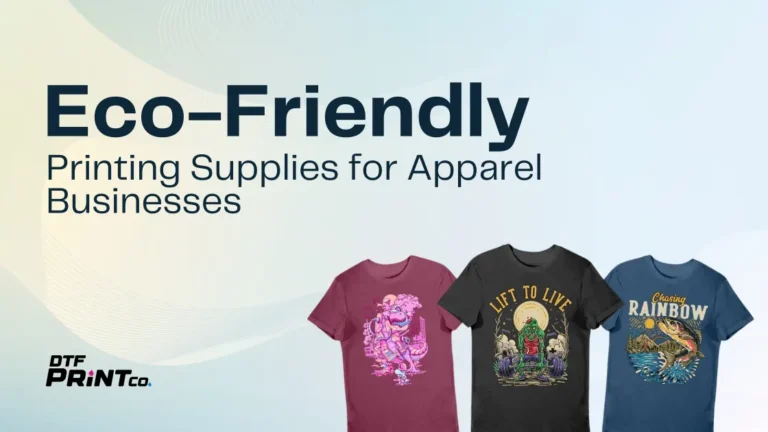Welcome to your go-to guide for Direct-to-Film (DTF) Printing! While selecting the right DTF Printer is crucial, this post zeroes in on the ten indispensable accessories and consumables—excluding the printer itself—that you must have to launch your DTF printing workflow. Each item below is engineered to ensure vibrant, durable, and wash-resistant transfers on any fabric.
- Pigment Ink Set
- PET Transfer Film
- Adhesive Powder
- Heat Press Machine
- Powder Shaker / Curing Oven
- RIP Software
- Pre-Treatment Solution
- Cleaning & Maintenance Kit
- Substrate Preparation Tools
- Safety & Ventilation Equipment
1. Pigment Ink Set
A top-quality Pigment Ink Set—comprising CMYK plus White Ink—is the cornerstone of any DTF operation, delivering the opacity and color vibrancy that make transfers pop on dark or light fabrics alike. When evaluating ink, look for:
- High Color Gamut and Lightfastness ratings
- Consistent Viscosity to prevent nozzle clogging
- OEKO-TEX or similar certifications for wash durability
For example, PrintWorks Direct’s complete DTF ink set features 1 L of Brilliant White Ink and 1 L each of True-Tone CMYK inks, all formulated and tested in the USA for industrial reliability and vivid, long-lasting results
2. PET Transfer Film
The PET Transfer Film serves as the substrate on which your design is printed and then transferred. Key considerations include:
- Hot-Peel vs. Cold-Peel compatibility with your workflow
- Film Thickness (70–90 µm) for optimal handling and ink absorption
- Release Coating Quality to ensure clean separation without ink smear
Heat Transfer Warehouse’s premium DTF film lineup offers both hot-peel and cold-peel PET transfer films engineered for superior ink adhesion, stretchability, and wash durability on cotton, polyester, and blends .
3. Adhesive Powder
Adhesive Powder—typically a thermoplastic polyurethane (TPU)—bonds the printed ink to the fabric when heat-pressed. Look for powders with:
- Particle Size between 120–170 µm for even coverage
- Softening Point around 110–130 °C for 15–20 s dwell times
- Excellent Washability up to 60 °C without cracking
STS Inks’ DTF White Powder delivers a finely milled TPU adhesive that melts uniformly under heat, yielding strong, flexible transfers that withstand repeated laundering.
4. Heat Press Machine
A high-performance Heat Press Machine is the heart of your DTF workflow, delivering the precise temperature, pressure, and dwell time required to fuse pigment inks and adhesive powder into the fabric. Key factors to consider include:
- Temperature Range & Accuracy: Look for digital controls spanning 100–200 °C with ±2 °C precision to accommodate various ink formulations and powder softening points.
- Pressure Uniformity: A self-leveling platen or swing-away design ensures even force across the entire transfer surface, preventing inconsistent adhesion or print artifacts.
- Platen Size & Configuration: Choose a platen large enough for your typical designs (e.g., 16×20″ for standard T-shirt transfers) or dual-station presses for high-volume runs.
- Automation & Presets: Programmable presets and air-regulator integration streamline repetitive jobs and reduce operator error.
For industrial reliability, the Digital Knight DK32AP offers 32″×26″ automation, 6 000 lb. force, and programmable cycle timers—ideal for large-format DTF applications
5. Powder Shaker / Curing Oven
To achieve consistent adhesive coverage and proper curing, a combined Powder Shaker / Curing Oven unit is invaluable. This dual-function device automates both the dusting of thermoplastic polyurethane (TPU) powder and the thermal fixation step. Look for:
- Adjustable Shake Timer: Fine-tune powder application time (5–15 s) to match particle size (120–170 µm) and design density.
- Variable Oven Temperature: Maintain 110–140 °C for uniform powder melting without overheating the film.
- Throughput Capacity: Sheet-by-sheet operation vs. tunnel conveyor designs for gang-sheet efficiency.
- Seamless Integration: Synchronization with your DTF printer’s output speed for a continuous production line.
The EnjoyColor DTF Curing Oven & Powder Shaker integrates shaking, dusting, and heating for films up to 13.4″ wide, creating a fully automated DTF production workflow
6. RIP Software
Raster Image Processor (RIP) Software controls the translation of your digital artwork into printer-readable commands, managing color profiling, white underbase generation, and halftone screening. Core capabilities include:
- White Underbase Control: Precisely define white ink layers to optimize opacity and save ink.
- Color Management: ICC profile support and Live Calibration ensure consistent, repeatable results across print runs.
- Halftone & Ink Limiting: Adjustable dot patterns and ink limits prevent over-saturation and drying issues.
- Printer Compatibility: Support for multiple brands and custom driver integration.
A leading solution, CADlink Digital Factory DTF, offers robust color tools and full support for A2-sized DTF machines, making it a go-to choice for both novices and production shops . Other popular RIP options include AcroRIP and EazyDTF, known for user-friendly interfaces and flexible licensing models
7. Pre-Treatment Solution
While DTF printing generally relies on adhesive powder rather than pre-treatment sprays, using a specialized Pre-Treatment Solution on certain fabrics (especially performance blends or dark substrates) can enhance ink adhesion, wash-fastness, and hand feel. Considerations:
- Solution Viscosity & Coverage: Uniform coating without saturating the fabric, applied via spray or dip.
- Curing Requirements: Pre-dry at 100–110 °C for 1–2 minutes to set the solution before transferring.
- Compatibility Testing: Wash and abrasion tests to validate long-term durability.
For fabrics prone to ink bleed or poor adhesion, pilot tests with a DTF-formulated pre-treatment—such as those explored in the Industrial Inks “Short Q\&A” guide—can help identify optimal product choices and application protocols
8. Cleaning & Maintenance Kit
A comprehensive Cleaning & Maintenance Kit is essential for preserving the performance and longevity of your DTF equipment. Key components include:
- DTF Cleaning Solution (100 – 250 mL) for flushing printheads
- Isopropyl Alcohol (IPA) wipes to remove ink residue and adhesive buildup
- Lintless Cleaning Swabs and Foam Swabs for precise nozzle and capping station cleaning
- Maintenance Syringes & Tubes to deliver solution directly into printhead dampers
For example, the DTF Station DTF Maintenance Kit bundles 1 kg of proprietary cleaning solution, 16 oz IPA, 50 cleaning swabs, and 30 lintless wipes—compatible with all Prestige DTF models—for thorough upkeep . Complement this with the DTF Printhead Maintenance Kit from DTG PRO, which includes a 100 mL maintenance solution plus accessories for both daily and weekly servicing .
9. Substrate Preparation Tools
Proper Substrate Preparation Tools ensure a clean, lint-free surface, critical for strong ink adhesion and defect-free transfers. Must-have items include:
- Lint Rollers to eliminate fabric fibers
- Surface Cleaners (e.g., mild detergents, IPA solutions) for non-fabric materials
- Heat-Resistant Tapes to mask and secure film alignment
- Flat Press Boards or Teflon Sheets to provide a smooth, stable pressing platform
Cleaning substrates removes contaminants such as dirt, grease, and loose fibers, which can cause ink bleeding or adhesive dropout. According to Southeast Prints, meticulous prep on porous surfaces—cotton, polyester blends, and even glass—dramatically enhances transfer durability and color vibrancy.
10. Safety & Ventilation Equipment
Ensuring a safe working environment is paramount when handling chemical solvents, adhesive powders, and high-temperature equipment. Essential safety gear includes:
- Respirator Masks (organic vapor + particulate filters) to protect against fumes and powder inhalation
- Nitrile Gloves for chemical handling and skin protection
- Ventilation Hoods or Fume Extractors to remove solvent vapors and airborne particulates
- Heat-Resistant Gloves for handling hot substrates and press platens
Investing in proper laboratory-grade PPE minimizes health risks and ensures compliance with safety regulations.
FAQ
What is the difference between hot-peel and cold-peel PET Transfer Film?
Hot-peel film separates from the substrate immediately while still warm, minimizing smudging but requiring swift handling. Cold-peel film allows the transfer to fully cool before removal, reducing ink lift on delicate fabrics. Choose according to your workflow speed and fabric type—see PET Transfer Film for more details.
How do I determine the optimal Adhesive Powder application?
Start by selecting a powder with the recommended particle size (120–170 µm) and test dwell times in your Powder Shaker / Curing Oven. Monitor coverage uniformity and conduct wash-fastness trials at 60 °C. Adjust shake duration and oven temperature until you achieve a consistent, flexible bond.
Which Pre-Treatment Solution should I use for performance blends?
Use a DTF-formulated spray that enhances ink adhesion without over-wetting the fabric. Apply in a thin, even coat and pre-dry at 100–110 °C for 1–2 minutes before printing. Refer to the Pre-Treatment Solution section for compatibility tips and testing protocols.
How often should I perform maintenance on my Heat Press Machine?
Daily wipe-downs of the platen with lintless wipes and weekly deep cleaning with your Cleaning & Maintenance Kit help prevent residue buildup. Flush printheads every 48 hours if idle, and inspect pressure calibration monthly to maintain precise temperature and pressure uniformity.
Can I use the same RIP Software for multiple DTF printers?
Many RIP solutions—such as CADlink Digital Factory DTF—support diverse printer brands and platen sizes. Ensure your chosen software offers customizable ICC profiles, white underbase controls, and driver integration for each model. See RIP Software for recommended options and feature comparisons.



